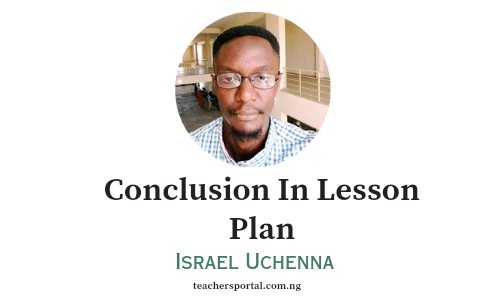In this article, we’ll explore the meaning of “Conclusion in Lesson Plan.” We’ll also offer tips on how to effectively write and implement conclusions in lesson plans. If you’re a teacher or student teacher and have little or no idea about this, read to the end for valuable insights.
Meaning of Conclusion in Lesson Plan
A conclusion in a lesson plan serves as a final summary of the key points covered in the lesson, reinforcing the learning objectives and providing a sense of closure. It helps students consolidate their understanding of the material and makes the transition from active learning to reflection and application easier.
Elements of Effective Lesson Plan Conclusion
Here are some essential elements of an effective lesson plan conclusion:
- Summarize the Main Points: Reiterate the key concepts, formulas, or principles discussed during the lesson. This helps students recall the essential information and connect it to the overall learning objectives.
- Reinforce Learning Objectives: Briefly review the lesson’s learning objectives and emphasize how the covered material contributes to achieving them. This reinforces the connection between the learning activities and the intended outcomes.
- Connect to Previous Lessons: Highlight how the current lesson builds upon previous learning experiences. This helps students see the progression of knowledge and the interconnectedness of concepts.
- Preview Next Steps: Briefly introduce the upcoming lesson or activity, providing a transition to the next learning phase. This helps students anticipate what’s coming and maintain engagement.
- Encourage Application: Pose questions or prompts that encourage students to apply the learned concepts to real-world scenarios or personal experiences. This fosters deeper understanding and practical application.
- Assess Understanding: Ask students to summarize the lesson in their own words or provide a short written reflection. This assesses their grasp of the material and identifies areas for additional support.
- Provide Closure: End the lesson with a positive and motivating statement, such as a quote, a thought-provoking question, or a reminder of the learning’s significance. This leaves a lasting impression and encourages further exploration.
A well-crafted conclusion helps students solidify their understanding, connects the lesson to the broader curriculum, and sets the stage for further learning. It serves as a valuable tool for effective pedagogy and student engagement.
How To Write Conclusion In Lesson Plan
In a lesson plan, the Conclusion stage follows the Evaluation phase. This stage involves revisiting the main points taught during the lesson. The teacher emphasizes key concepts, marks notes, and may provide students with additional information to copy while also checking and making necessary corrections.
The main point of the lesson, centered around the topic, serves as a summary. This summary, also known as the conclusion or summing-up, sheds additional light on the treated topic to enhance understanding.
In essence, the conclusion encapsulates the fundamental points intended for students to grasp by the lesson’s end.
Conclusions in a lesson can take various forms, such as assigning tasks and preparing students for the next lesson. Often, teachers perceive conclusion and summary as nearly synonymous due to their close resemblance.
To conclude, ensure all learners grasp new concepts during the day, verify the completion of classwork with appropriate answers, and assign homework. Books should be submitted for marking and correction.
Conclude the lesson by summarizing key points—a recap of vital lessons. The teacher addresses student questions, reiterates main points, marks classwork, and provides corrections, among others.
It’s important to note that the Evaluation phase and the Assignment Phase are different from the Conclusion Phase. The Conclusion comes after the Evaluation phase and before the Assignment Phase.
Conclusion In Lesson Plan Example
| STAGE | Teacher’s Activities | Students Activities | Learning Points |
| EVALUATION | |||
| CONCLUSION | Teacher concludes by correcting students wrong answers and gives them note on the board. | Responds to the teacher and copy note on their exercise books. | Consolidating of concepts learnt in the lesson. |
| ASSIGNMENT |
